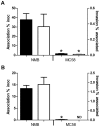Attachment and invasion of Neisseria meningitidis to host cells is related to surface hydrophobicity, bacterial cell size and capsule
- PMID: 23405216
- PMCID: PMC3566031
- DOI: 10.1371/journal.pone.0055798
Attachment and invasion of Neisseria meningitidis to host cells is related to surface hydrophobicity, bacterial cell size and capsule
Abstract
We compared exemplar strains from two hypervirulent clonal complexes, strain NMB-CDC from ST-8/11 cc and strain MC58 from ST-32/269 cc, in host cell attachment and invasion. Strain NMB-CDC attached to and invaded host cells at a significantly greater frequency than strain MC58. Type IV pili retained the primary role for initial attachment to host cells for both isolates regardless of pilin class and glycosylation pattern. In strain MC58, the serogroup B capsule was the major inhibitory determinant affecting both bacterial attachment to and invasion of host cells. Removal of terminal sialylation of lipooligosaccharide (LOS) in the presence of capsule did not influence rates of attachment or invasion for strain MC58. However, removal of either serogroup B capsule or LOS sialylation in strain NMB-CDC increased bacterial attachment to host cells to the same extent. Although the level of inhibition of attachment by capsule was different between these strains, the regulation of the capsule synthesis locus by the two-component response regulator MisR, and the level of surface capsule determined by flow cytometry were not significantly different. However, the diplococci of strain NMB-CDC were shown to have a 1.89-fold greater surface area than strain MC58 by flow cytometry. It was proposed that the increase in surface area without changing the amount of anchored glycolipid capsule in the outer membrane would result in a sparser capsule and increase surface hydrophobicity. Strain NMB-CDC was shown to be more hydrophobic than strain MC58 using hydrophobicity interaction chromatography and microbial adhesion-to-solvents assays. In conclusion, improved levels of adherence of strain NMB-CDC to cell lines was associated with increased bacterial cell surface and surface hydrophobicity. This study shows that there is diversity in bacterial cell surface area and surface hydrophobicity within N. meningitidis which influence steps in meningococcal pathogenesis.
Conflict of interest statement
Figures






References
-
- Stephens DS, Greenwood B, Brandtzaeg P (2007) Epidemic meningitis, meningococcaemia, and Neisseria meningitidis . Lancet 369: 2196–2210. - PubMed
-
- Claus H, Maiden MC, Maag R, Frosch M, Vogel U (2002) Many carried meningococci lack the genes required for capsule synthesis and transport. Microbiology 148: 1813–1819. - PubMed
-
- Dolan-Livengood JM, Miller YK, Martin LE, Urwin R, Stephens DS (2003) Genetic basis for nongroupable Neisseria meningitidis . J Infect Dis 187: 1616–1628. - PubMed
-
- Caugant DA (2008) Genetics and evolution of Neisseria meningitidis: importance for the epidemiology of meningococcal disease. Infect Genet Evol 8: 558–565. - PubMed
Publication types
MeSH terms
Substances
Grants and funding
LinkOut - more resources
Full Text Sources
Other Literature Sources
Medical

